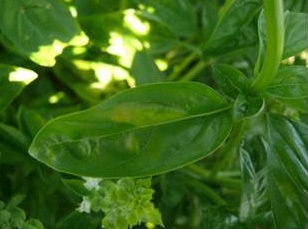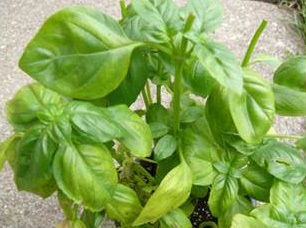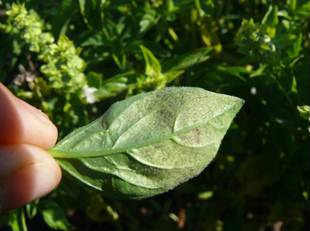Basil downy mildew
Learn how to identify basil downy mildew.
Basil downy mildew was detected in a home garden in the Greater Toronto Area this week. While there have been no reports from commercial basil fields so far this year, the presence of symptoms in home gardens means inoculum may be present in the air. Current conditions are conducive to spread of the disease. Ontario basil growers should be scouting their fields closely for symptoms of downy mildew in basil.
Look for general leaf chlorosis and stunting. Symptoms may superficially resemble a nutritional problem; however the leaf chlorosis, or yellowing, of infected leaves is initially confined to sections of the leaf bounded by the veins, whereas a nutritional disorder would typically affect the entire leaf.
The undersides of leaves infected with downy mildew often has a covering of purplish-grey spores, which can appear as a fuzzy grey growth to the naked eye. Note that this growth may be more obvious in the early morning when leaf surfaces are wet.
If downy mildew is detected in basil, the following preventative fungicides are registered for management of this disease. Note that the information does not replace the product label. Before application, consult the product label.
- Ranman and Torrent (cyazofamid), at a rate of 0.20-0.22 L/ha is registered for control of downy mildew in field and greenhouse basil. There is a 12-hr re-entry (REI), 0 day preharvest interval (PHI) and a maximum of 4 applications of Ranman per year. Do not exceed more than one application of Ranman/Torrent or other Group 21 fungicide out of every three fungicide applications.
- Revus (mandipropamid) is also registered for control of downy mildew in field and greenhouse basil at a rate of 583 ml/ha, with a 12-hr REI, 1 day PHI and a maximum 4 applications of Revus per year. Rotate with fungicides that are not in Group 40.
- Confine Extra (phosphorous acid) is registered for suppression of downy mildew on field basil at a rate of 3-5 L/ha, with a 1 day PHI. Do not make more than 6 applications of Confine Extra per season, and rotate with fungicides that are not in Group 33.
There are no organically acceptable products are currently registered for the control of basil downy mildew in Canada. Cultural practices that promote air flow and reduce leaf wetness may help organic growers control this disease. These include locating plants away from sheltered areas, planting rows parallel to prevailing wind directions, reducing planting densities and using drip irrigation if possible.
For more photos of disease symptoms and information on downy mildew biology, refer to the Cornell University basil downy mildew page. Note that this is a US site which refers to fungicides that are not registered in Ontario. Ontario growers can only use products registered in Canada by the PMRA.


